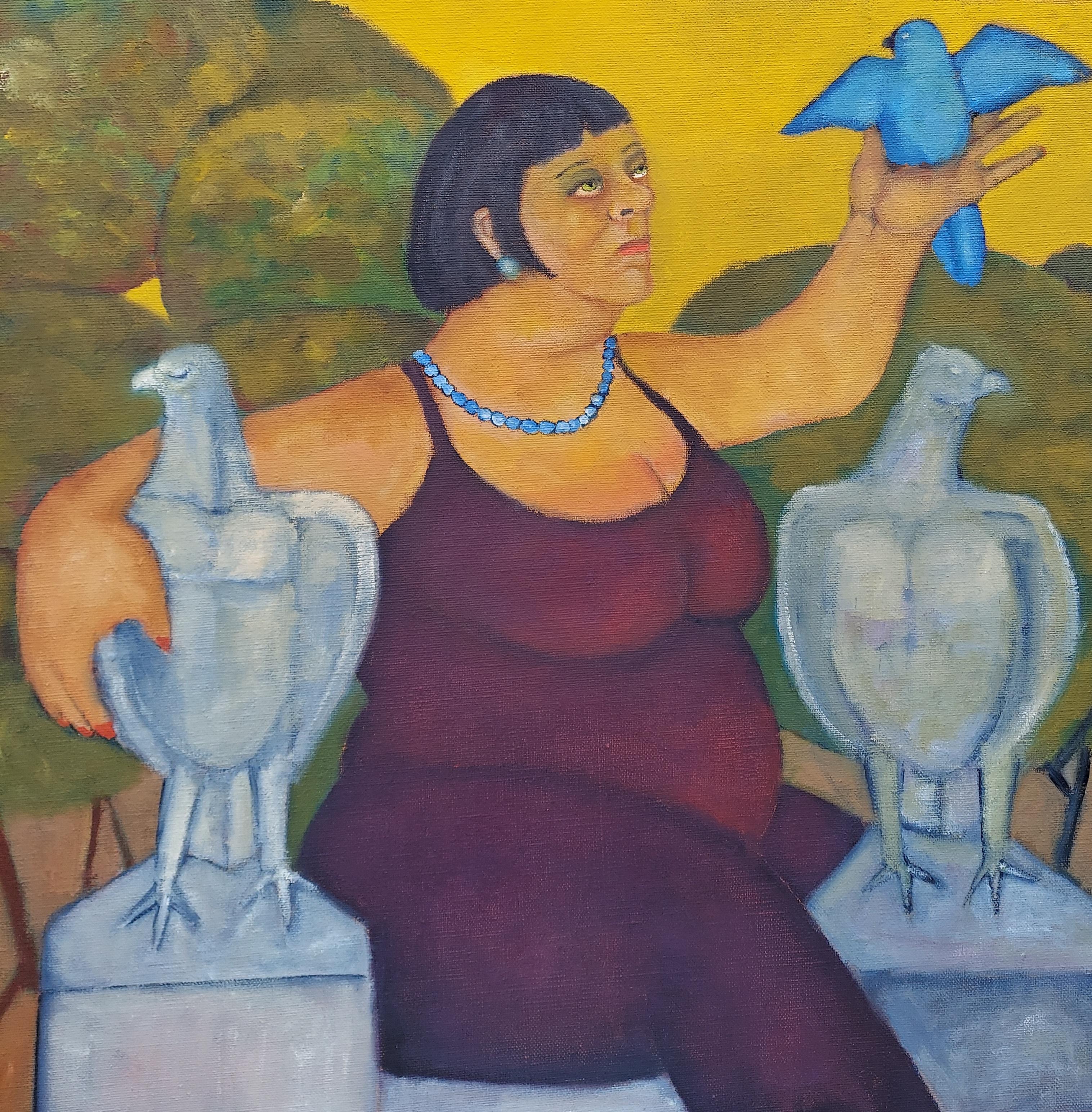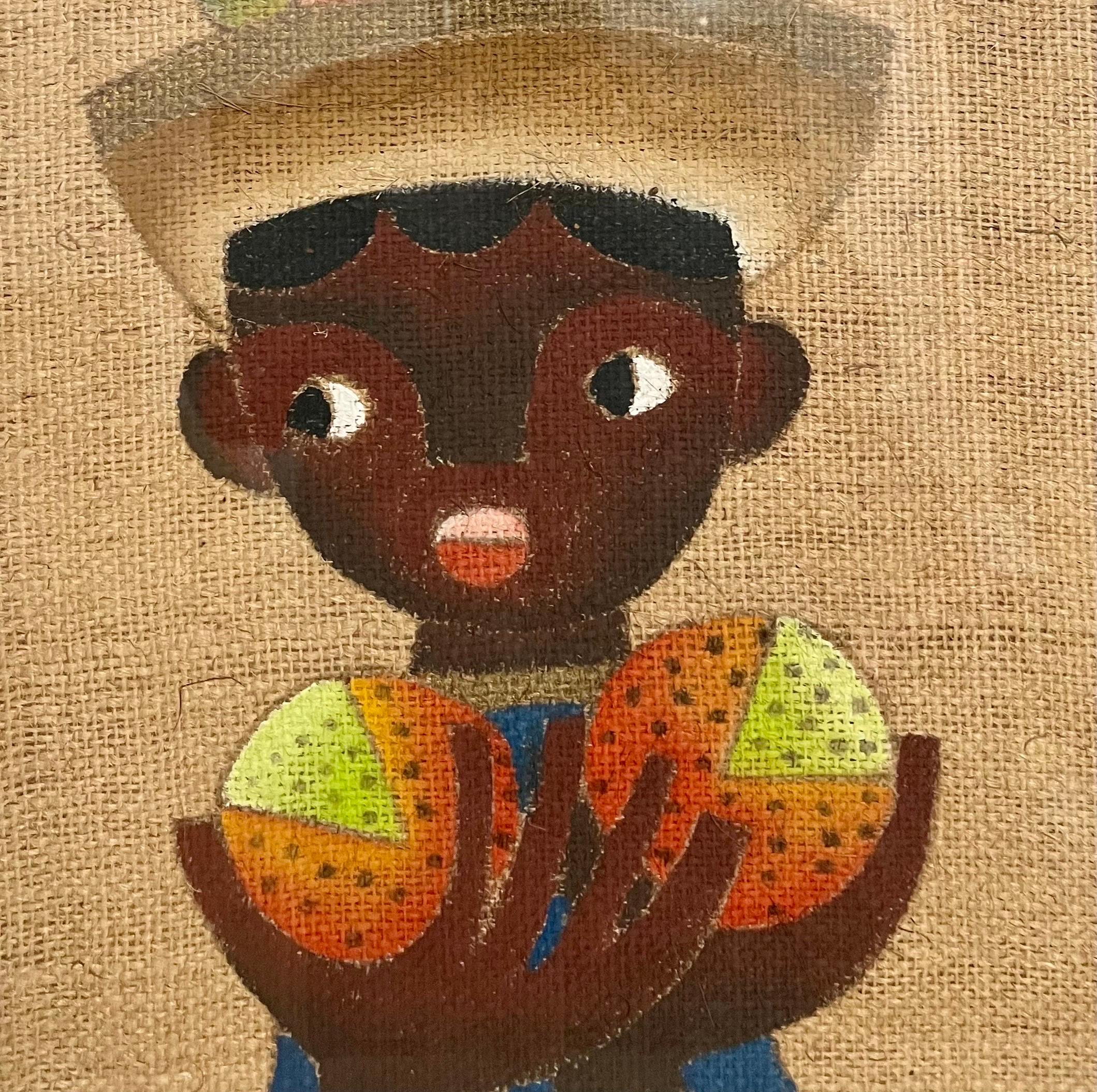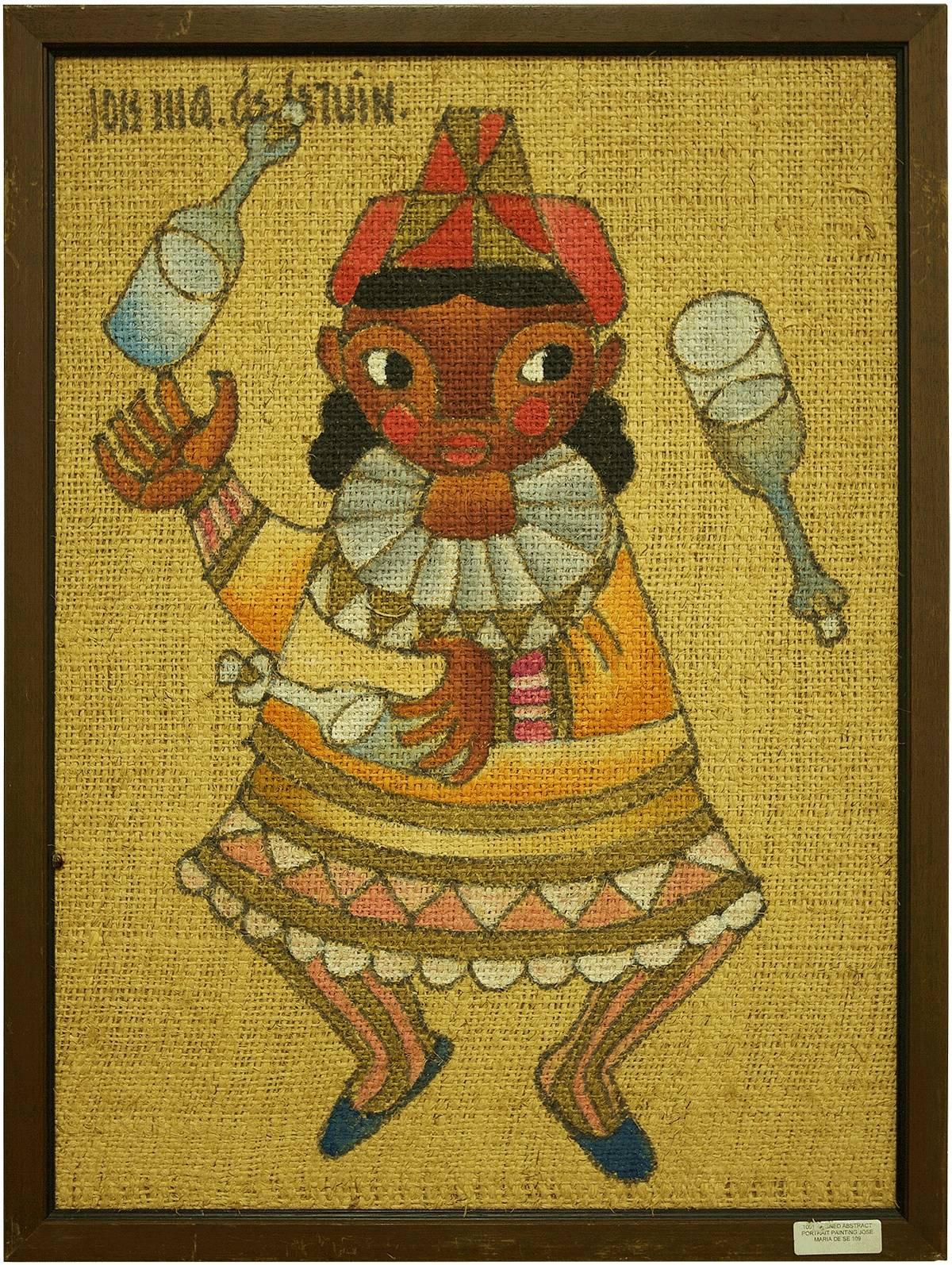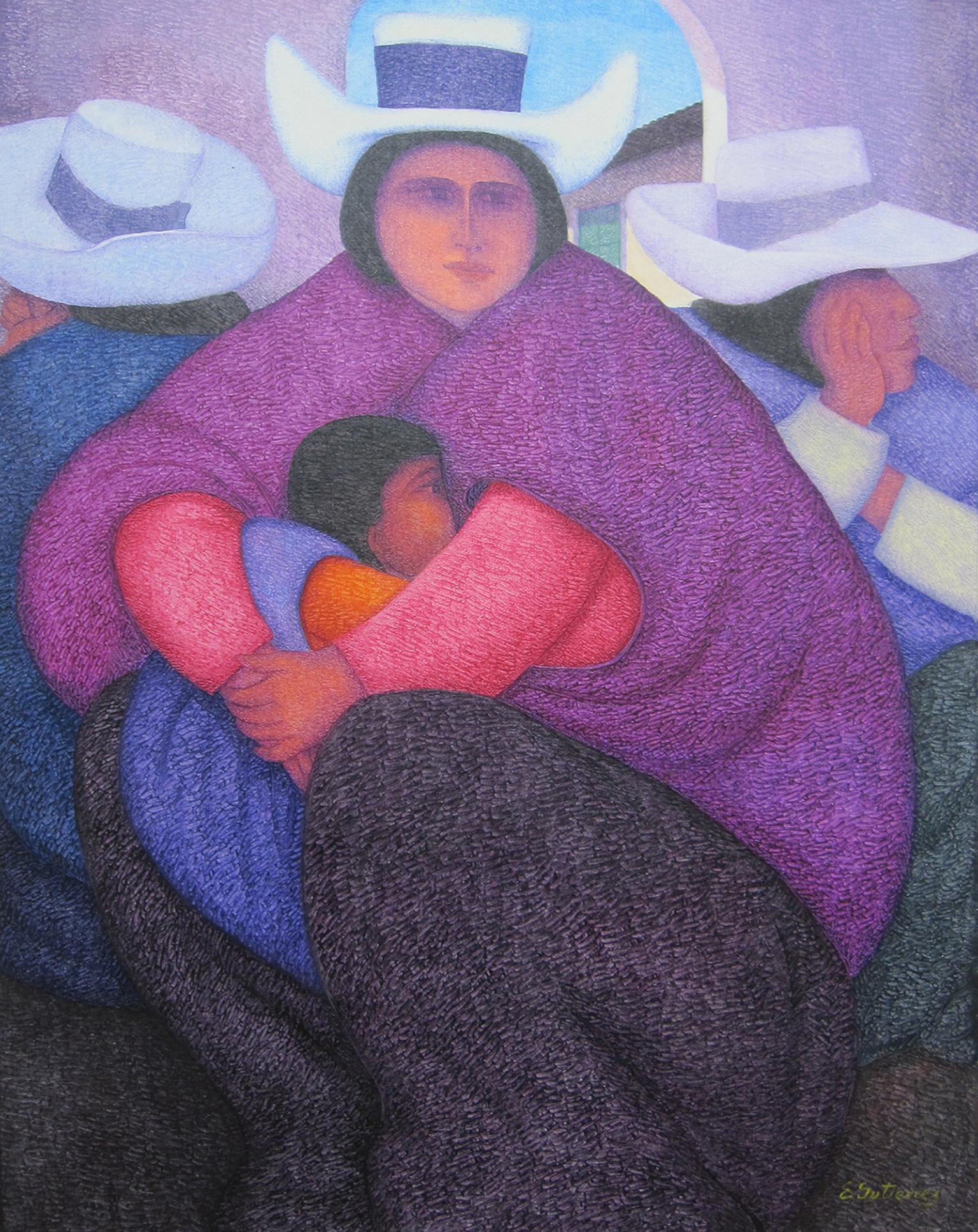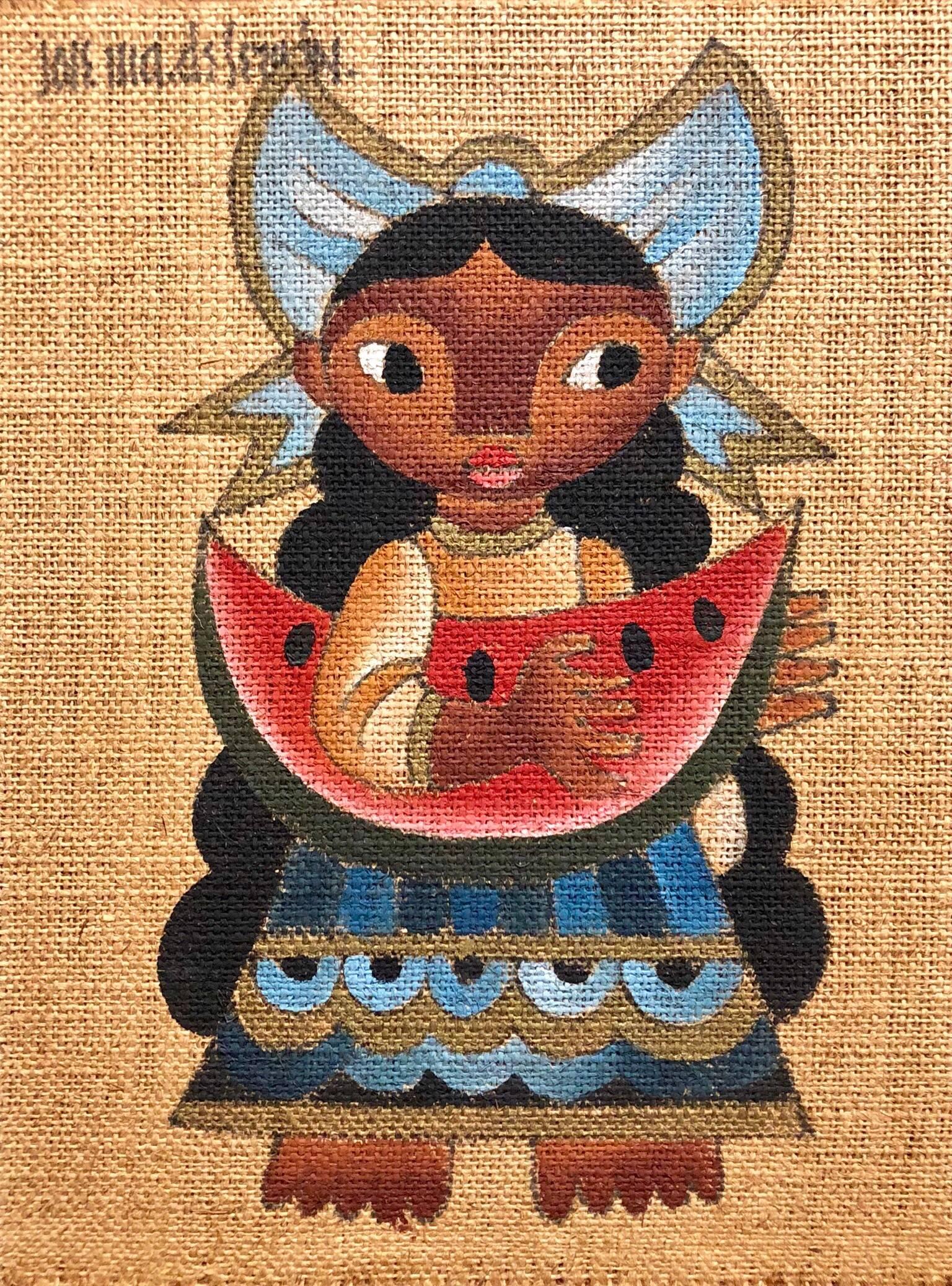Items Similar to Folk Art Mexican Girl Oil Painting on Burlap Charming Naive African American Art
Want more images or videos?
Request additional images or videos from the seller
1 of 11
Jose Maria de ServinFolk Art Mexican Girl Oil Painting on Burlap Charming Naive African American Art
About the Item
Framed 29 X 23
Image 18 X 24
The sweetness that characterizes the work of Mexican painter Jose Maria de Servin (1917-83) is a melancholy and placid one. While he worked in the most modern of styles, he adapted it to an anecdotal folk-art approach distinctly his own.
When he was an infant, de Servin's family moved with him to Guadalajara. A city of history and culture, Guadalajara had a thriving artistic community with strong connections to Europe. His brothers Antonio and Miguel became artists as well, and in later years they worked collaboratively. As a teenager, de Servin studied at one of Mexico's Schools of Open-Air Painting, free art-teaching institutions sponsored by the government.
Later de Servin became a pupil of the painter Chucho Reyes, known for his improvisational watercolor variations on traditional Mexican themes. This interest in imagery particular to Mexico would be of great significance to de Servin. De Servin also studied under the more traditional painter Jose Vizcarra. In the early 1930s de Servin joined the Pintores Jovenes de Jalisco, or Young Painters of Jalisco.
An influence of critical importance to de Servin was Pablo Picasso. One of the originators of Cubism, the Spanish painter soon departed from its quasi-scientific and optical basis to create lively and humorous geometrical abstractions. It was this Cubism, personal and decorative, that de Servin adopted. His earliest Cubist works mimic Picasso, while during the second stage of his career, his works become smooth and polished, with an emphasis on gentle surface textures.
After these cautious years, however, a rough boldness enters along with dominating colors of earth and sand. Modernists like de Servin were interested in exploring what they considered primitive artmaking styles. The adoption of a native manner and native themes is in keeping with Modernist tenets, as is the use of nontraditional materials. De Servin's portraits of peasants, large-eyed and simply rendered, recall children's drawings. The rough burlap ground contrasts with the playful imagery and delicate range of color. The figures, all children or child-like adults, are all curves and simple shapes arranged harmoniously. De Servin's cubism is free from grotesquerie as it celebrates the simplicity of its subjects.
De Servin worked with the social-realist Jose Orozco on several large mural commissions in Guadalajara, including one at the Legislative Palace. While their styles were dissimilar, both made use of Mexican imagery to glorify the common people. A sought-after muralist in his own right, de Servin brought the rich colors and endearing characters of his panels to his larger-scale work.
For 15 years, de Servin taught summer art classes at the University of Arizona. His career was marked by many one-man shows, both in North America and Europe. In recent years, his striking style has attracted increased notice from critics and the public.
His style is a unique conglomerate of tradition, history, legends, heroes, old customs and folklore. It is a self-standing style, recognizable, cheerful, whimsical and a happy creation. Naïve art is any form of visual art that is created by a person who lacks the formal education and training that a professional artist undergoes (in anatomy, art history, technique, perspective, ways of seeing). Unlike folk art, naïve art does not necessarily evince a distinct cultural context or tradition. Naïve art is recognized, and often imitated, for its childlike simplicity and frankness. Paintings of this kind typically have a flat rendering style with a rudimentary expression of perspective.
One particularly influential painter of "naïve art" was Henri Rousseau (1844–1910), a French Post-Impressionist who was discovered by Pablo Picasso. Naïve art is often seen as outsider art that is by someone without formal (or little) training or degree. While this was true before the twentieth century, there are now academies for naïve art. Naïve art is now a fully recognized art genre, represented in art galleries worldwide.
Museums devoted to naïve art now exist in Kecskemét, Hungary; Riga, Latvia; Jaen, Spain; Rio de Janeiro, Brasil; Vicq France and Paris. "Primitive art" is another term often applied to art by those without formal training, but is historically more often applied to work from certain cultures that have been judged socially or technologically "primitive" by Western academia, such as Native American, sub saharan African or Pacific Island art (see Tribal art). This is distinguished from the self-conscious, "primitive" inspired movement primitivism. Another term related to (but not completely synonymous with) naïve art is folk art. There also exist the terms "naïvism" and "primitivism" which are usually applied to professional painters working in the style of naïve art (like Paul Gauguin, Mikhail Larionov, Paul Klee).
At all events, naive art can be regarded as having occupied an "official" position in the annals of twentieth-century art since - at the very latest - the publication of the Der Blaue Reiter, an almanac in 1912. Wassily Kandinsky and Franz Marc, who brought out the almanac, presented 6 reproductions of paintings by le Douanier' Rousseau (Henri Rousseau), comparing them with other pictorial examples. However, most experts agree that the year that naive art was "discovered" was 1885, when the painter Paul Signac became aware of the talents of Henri Rousseau and set about organizing exhibitions of his work in a number of prestigious galleries. The Earth Group (Grupa Zemlja) were Croatian artists, architects and intellectuals active in Zagreb from 1929 to 1935. The group included the painters Krsto Hegedušić, Edo Kovačević, Omer Mujadžić, Kamilo Ružička, Ivan Tabaković, and Oton Postružnik, the sculptors Antun Augustinčić, Frano Kršinić, and the architect Drago Ibler. A term applied to Yugoslav (Croatian) naive painters working in or around the village of Hlebine, near the Hungarian border, from about 1930. Some of the best known naive artists are Dragan Gaži, Ivan Generalić, Josip Generalić, Krsto Hegedušić, Mijo Kovačić, Ivan Lacković-Croata, Franjo Mraz, Ivan Večenaj and Mirko Virius. Camille Bombois (1883–1970) Ferdinand Cheval, known as 'le facteur Cheval' (1836–1924) Henry Darger (1892–1973) L. S. Lowry (1887–1976) Grandma Moses, Anna Mary Robertson (1860–1961) Nikifor (1895–1968) Poland, Horace Pippin (1888–1946) Jon Serl (1894-1993) United States Alfred Wallis (1855–1942) Scottie Wilson (1890–1972) Gesner Abelard (b. 1922) Jan Balet (1913–2009) Michel Delacroix (b. 1933) France Howard Finster (1916–2001) Ivan Rabuzin (1921–2008)
Spontaneous Art Museum in Brussels
Art en Marge Museum in Brussels
MADmusée in Liege
International Museum of Naive Art of Brazil in Cosme Velho, Rio de Janeiro
Gallery Jacques Ardies in São Paulo
Musée international d'art naïf de Magog in Magog
Croatian Museum of Naïve Art in Zagreb
Gallery of Croatian Naïve Art in Zagreb
Croatian Naive Art Museum in Hlebine
Musée international d'Art naïf Anatole Jakovsky in Nice
Musée d'Art Naïf - Max Fourny in Paris
International Museum of Naive Art in Vicq (near Versailles)
Museum of Naive Art in Beraut (near Toulouse)
Museum Charlotte Zander in Bönnigheim
Gesellschaft für Naive Kunst in Hannover
Museum of Hungarian Naive Artists in Kecskemét
Gallery of International Naïve Art (GINA) in Tel Aviv
Naive Art Museum in Moscow
Collection of naïve and outsider art of Dr. X. Bogucharskaia and A.Turchin
Anthony Petullo Collection of Self-Taught & Outsider Art
American Visionary Art Museum in Baltimore, MD
- Creator:Jose Maria de Servin (1917, Mexican)
- Dimensions:Height: 29 in (73.66 cm)Width: 23 in (58.42 cm)
- Medium:
- Movement & Style:
- Period:
- Condition:Being shipped with no glass. burlap mounted to board. minor toning to burlap please see photos. shows well. original frame with some light wear but structurally sound..
- Gallery Location:Surfside, FL
- Reference Number:1stDibs: LU38211393672
About the Seller
4.9
Platinum Seller
These expertly vetted sellers are 1stDibs' most experienced sellers and are rated highest by our customers.
Established in 1995
1stDibs seller since 2014
1,550 sales on 1stDibs
Typical response time: 1 hour
- ShippingRetrieving quote...Ships From: Surfside, FL
- Return PolicyA return for this item may be initiated within 3 days of delivery.
More From This SellerView All
- Folk Art Mexican Girl "Emborrachate" Oil Painting on BurlapBy Jose Maria de ServinLocated in Surfside, FLThe sweetness that characterizes the work of Mexican painter Jose Maria de Servin (1917-83) is a melancholy and placid one. While he worked in the most modern of styles, he adapted i...Category
Mid-20th Century Folk Art Figurative Paintings
MaterialsBurlap, Oil
- Folk Art Mexican Boy Oil Painting on Burlap Charming Naive African American ArtBy Jose Maria de ServinLocated in Surfside, FLFramed 29 X 23 Image 18 X 24 The sweetness that characterizes the work of Mexican painter Jose Maria de Servin (1917-83) is a melancholy and placid one. While he worked in the most modern of styles, he adapted it to an anecdotal folk-art approach distinctly his own. When he was an infant, de Servin's family moved with him to Guadalajara. A city of history and culture, Guadalajara had a thriving artistic community with strong connections to Europe. His brothers Antonio and Miguel became artists as well, and in later years they worked collaboratively. As a teenager, de Servin studied at one of Mexico's Schools of Open-Air Painting, free art-teaching institutions sponsored by the government. Later de Servin became a pupil of the painter Chucho Reyes, known for his improvisational watercolor variations on traditional Mexican themes. This interest in imagery particular to Mexico would be of great significance to de Servin. De Servin also studied under the more traditional painter Jose Vizcarra. In the early 1930s de Servin joined the Pintores Jovenes de Jalisco, or Young Painters of Jalisco. An influence of critical importance to de Servin was Pablo Picasso. One of the originators of Cubism, the Spanish painter soon departed from its quasi-scientific and optical basis to create lively and humorous geometrical abstractions. It was this Cubism, personal and decorative, that de Servin adopted. His earliest Cubist works mimic Picasso, while during the second stage of his career, his works become smooth and polished, with an emphasis on gentle surface textures. After these cautious years, however, a rough boldness enters along with dominating colors of earth and sand. Modernists like de Servin were interested in exploring what they considered primitive artmaking styles. The adoption of a native manner and native themes is in keeping with Modernist tenets, as is the use of nontraditional materials. De Servin's portraits of peasants, large-eyed and simply rendered, recall children's drawings. The rough burlap ground contrasts with the playful imagery and delicate range of color. The figures, all children or child-like adults, are all curves and simple shapes arranged harmoniously. De Servin's cubism is free from grotesquerie as it celebrates the simplicity of its subjects. De Servin worked with the social-realist Jose Orozco on several large mural commissions in Guadalajara, including one at the Legislative Palace. While their styles were dissimilar, both made use of Mexican imagery to glorify the common people. A sought-after muralist in his own right, de Servin brought the rich colors and endearing characters of his panels to his larger-scale work. For 15 years, de Servin taught summer art classes at the University of Arizona. His career was marked by many one-man shows, both in North America and Europe. In recent years, his striking style has attracted increased notice from critics and the public. His style is a unique conglomerate of tradition, history, legends, heroes, old customs and folklore. It is a self-standing style, recognizable, cheerful, whimsical and a happy creation. Naïve art is any form of visual art that is created by a person who lacks the formal education and training that a professional artist undergoes (in anatomy, art history, technique, perspective, ways of seeing). Unlike folk art, naïve art does not necessarily evince a distinct cultural context or tradition. Naïve art is recognized, and often imitated, for its childlike simplicity and frankness. Paintings of this kind typically have a flat rendering style with a rudimentary expression of perspective. One particularly influential painter of "naïve art" was Henri Rousseau (1844–1910), a French Post-Impressionist who was discovered by Pablo Picasso. Naïve art is often seen as outsider art that is by someone without formal (or little) training or degree. While this was true before the twentieth century, there are now academies for naïve art. Naïve art is now a fully recognized art genre, represented in art galleries worldwide. Museums devoted to naïve art now exist in Kecskemét, Hungary; Riga, Latvia; Jaen, Spain; Rio de Janeiro, Brasil; Vicq France and Paris. "Primitive art" is another term often applied to art by those without formal training, but is historically more often applied to work from certain cultures that have been judged socially or technologically "primitive" by Western academia, such as Native American, sub saharan African or Pacific Island art (see Tribal art). This is distinguished from the self-conscious, "primitive" inspired movement primitivism. Another term related to (but not completely synonymous with) naïve art is folk art. There also exist the terms "naïvism" and "primitivism" which are usually applied to professional painters working in the style of naïve art (like Paul Gauguin, Mikhail Larionov, Paul Klee). At all events, naive art can be regarded as having occupied an "official" position in the annals of twentieth-century art since - at the very latest - the publication of the Der Blaue Reiter, an almanac in 1912. Wassily Kandinsky and Franz Marc, who brought out the almanac, presented 6 reproductions of paintings by le Douanier' Rousseau (Henri Rousseau), comparing them with other pictorial examples. However, most experts agree that the year that naive art was "discovered" was 1885, when the painter Paul Signac became aware of the talents of Henri Rousseau and set about organizing exhibitions of his work in a number of prestigious galleries. The Earth Group (Grupa Zemlja) were Croatian artists, architects and intellectuals active in Zagreb from 1929 to 1935. The group included the painters Krsto Hegedušić, Edo Kovačević, Omer Mujadžić, Kamilo Ružička, Ivan Tabaković, and Oton Postružnik, the sculptors Antun Augustinčić, Frano Kršinić, and the architect Drago Ibler. A term applied to Yugoslav (Croatian) naive painters working in or around the village of Hlebine, near the Hungarian border, from about 1930. Some of the best known naive artists are Dragan Gaži, Ivan Generalić, Josip Generalić, Krsto Hegedušić, Mijo Kovačić, Ivan Lacković-Croata, Franjo Mraz, Ivan Večenaj and Mirko Virius. Camille Bombois (1883–1970) Ferdinand Cheval, known as 'le facteur Cheval' (1836–1924) Henry Darger (1892–1973) L. S. Lowry (1887–1976) Grandma Moses, Anna Mary Robertson (1860–1961) Nikifor (1895–1968) Poland, Horace Pippin (1888–1946) Jon Serl (1894-1993) United States Alfred Wallis (1855–1942) Scottie Wilson (1890–1972) Gesner Abelard...Category
Mid-20th Century Folk Art Figurative Paintings
MaterialsBurlap, Oil
- Folk Art Mexican Girl, Circus Clown JugglerBy Jose Maria de ServinLocated in Surfside, FLThe sweetness that characterizes the work of Mexican painter Jose Maria de Servin (1917-83) is a melancholy and placid one. While he worked in the most modern of styles, he adapted i...Category
Mid-20th Century Folk Art Figurative Paintings
MaterialsBurlap, Oil
- Folk Art Mexican Girl with Watermelon Oil Painting on BurlapBy Jose Maria de ServinLocated in Surfside, FLThe sweetness that characterizes the work of Mexican painter Jose Maria de Servin (1917-83) is a melancholy and placid one. While he worked in the most modern of styles, he adapted i...Category
Mid-20th Century Folk Art Figurative Paintings
MaterialsBurlap, Oil
- Whimsical French Folk Art, Naive, Oil Painting Madeline Marie Christine ClavierBy Madeline Christine ClavierLocated in Surfside, FLMADELINE CHRISTINE CLAVIER (1913-2015) Signature: Signed lower right & titled verso Medium: Oil on canvas Provenance: The collection of the artist's family Marie Christine Clavier was born in Saigon, Vietnam in 1913 to French parents and lived there for her formative years. She returned to France as a teenager and began to study painting. Her work quickly developed into whimsical paintings of poetry and songs – harmonized in a unique and distinct painting technique. Her work has an impasto feel and a folk art, outsider artist sensibility to it. Similar in style to Maik and other fantasy realists who use animals, flowers and foliage in their artworks. Marie Clavier painted ro herself rather than for profit as she was quite independently wealthy. She exhibited extensively in the United States in the 1970s especially across Connecticut and New York, showing at various galleries and cultural centres. She had numerous solo exhibitions in the 1970’s- notably at the Maison Francaise in New York and New York University. She showed at Galerie Bernheim Jeune in Paris. She won many awards for her work including Gold Medals and Palme D’Or medals. In 1988 the prestigious art publisher Leopard D’Or produced catalogue book on her life and work – by this point she had virtually given up painting. She died in 2015 aged 102. Bernheim-Jeune gallery is one of the oldest art galleries in Paris. Opened on Rue Laffitte in 1863 by Alexandre Bernheim (1839-1915), friend of Delacroix, Corot and Courbet, it changed location a few times before settling on Avenue Matignon. The gallery promoted realists, Barbizon school paintings and, in 1874, the first impressionist and later post-impressionist painters. It closed in 2019. In 1901, Alexandre Bernheim, with his sons, Josse (1870-1941), and Gaston (1870-1953), organized the first important exhibition of Vincent van Gogh paintings in Paris with the help of art critic Julien Leclercq. In 1906, Bernheim-Jeune frères started presenting works by Pierre Bonnard, Edouard Vuillard, Paul Cezanne, Henri-Edmond Cross, Kees van Dongen, Henri Matisse, Le Douanier Rousseau, Raoul Dufy, Maurice de Vlaminck, Amedeo Modigliani, Maurice Utrillo and Georges Dufrenoy...Category
20th Century Folk Art Animal Paintings
MaterialsCanvas, Oil
- Large Naive European Folk Art Oil Painting Lazar Obican French Scarecrow ClownLocated in Surfside, FLLazar Obican 1944-2004 Genre: Other Subject: People Medium: Oil Surface: Canvas Dimensions: 35" x 16.5 Dimensions w/Frame: 35.5" x 17.25 An impasto composition that depicts a colorful scarecrow clown with a bird perched on his shoulder with a bottle of French Vin (wine) Artist signature L OBICAN to bottom and dated 1968. Title to verso. Work Size: 36 x 25 in. Framed 37.5 x 26 x 1 in The artist Lazar Obican iconic style is child-like yet masterfully adult; a style that tells a story with sociological overtones. His funny little people are always colorful, full of spirit, living with music and birds to bring them happiness. Lazar Obican artist, painter, sculpture and mosaic ceramic artisan was born in Cannes, France, to his Yugoslavian family. He finished his training, imbued with the spirit of his native country, the people, their legends, and their philosophy. It has been said that his work has a "timeless quality" and a naive, folk art, outsider art brut quality, child-like primitive style. Obican is identified with his style the world over, a style that is simple yet sophisticated; child-like yet masterfully adult; a style that tells a story with psychological, philosophical or sociological overtones. His funny little people are always colorful, full of spirit, living with music and birds to bring them happiness. Best known for his depictions of folklore and traditional costumes rendered in a playful, childlike style and for his happy Jewish wedding scenes. He often used bright colors and black outlines in his renderings of figures and animals, giving his work an illustration-like quality. Thematically, the artist’s work is similar to Marc Chagall and Jean Dubuffet for its dreamlike images and so-called naïve style of painting. Over the course of his career, the artist maintained a studio in Boca Raton, Florida and Dubrovnik, Croatia—part of former Yugoslavia— where he developed an interest in Eastern Europe’s Jewish culture. Many of his mature works depict Jewish traditions and ceremonies, including traditional Jewish weddings, the dancing of the Hora, and traditional music. There is a display of his works in his former Dubrovnik studio. His style is a unique conglomerate of tradition, history, legends, heroes, old customs and folklore. It is a self-standing style, recognizable, cheerful, whimsical and a happy creation. Naïve art is any form of visual art that is created by a person who lacks the formal education and training that a professional artist undergoes (in anatomy, art history, technique, perspective, ways of seeing). Unlike folk art, naïve art does not necessarily evince a distinct cultural context or tradition. Naïve art is recognized, and often imitated, for its childlike simplicity and frankness. Paintings of this kind typically have a flat rendering style with a rudimentary expression of perspective. One particularly influential painter of "naïve art" was Henri Rousseau (1844–1910), a French Post-Impressionist who was discovered by Pablo Picasso. Naïve art is often seen as outsider art that is by someone without formal (or little) training or degree. While this was true before the twentieth century, there are now academies for naïve art. Naïve art is now a fully recognized art genre, represented in art galleries worldwide. Museums devoted to naïve art now exist in Kecskemét, Hungary; Riga, Latvia; Jaen, Spain; Rio de Janeiro, Brasil; Vicq France and Paris. "Primitive art" is another term often applied to art by those without formal training, but is historically more often applied to work from certain cultures that have been judged socially or technologically "primitive" by Western academia, such as Native American, sub saharan African or Pacific Island art (see Tribal art). This is distinguished from the self-conscious, "primitive" inspired movement primitivism. Another term related to (but not completely synonymous with) naïve art is folk art. There also exist the terms "naïvism" and "primitivism" which are usually applied to professional painters working in the style of naïve art (like Paul Gauguin, Mikhail Larionov, Paul Klee). At all events, naive art can be regarded as having occupied an "official" position in the annals of twentieth-century art since - at the very latest - the publication of the Der Blaue Reiter, an almanac in 1912. Wassily Kandinsky and Franz Marc, who brought out the almanac, presented 6 reproductions of paintings by le Douanier' Rousseau (Henri Rousseau), comparing them with other pictorial examples. However, most experts agree that the year that naive art was "discovered" was 1885, when the painter Paul Signac became aware of the talents of Henri Rousseau and set about organizing exhibitions of his work in a number of prestigious galleries. The Earth Group (Grupa Zemlja) were Croatian artists, architects and intellectuals active in Zagreb from 1929 to 1935. The group included the painters Krsto Hegedušić, Edo Kovačević, Omer Mujadžić, Kamilo Ružička, Ivan Tabaković, and Oton Postružnik, the sculptors Antun Augustinčić, Frano Kršinić, and the architect Drago Ibler. A term applied to Yugoslav (Croatian) naive painters working in or around the village of Hlebine, near the Hungarian border, from about 1930. Some of the best known naive artists are Dragan Gaži, Ivan Generalić, Josip Generalić, Krsto Hegedušić, Mijo Kovačić, Ivan Lacković-Croata, Franjo Mraz, Ivan Večenaj and Mirko Virius. Camille Bombois (1883–1970) Ferdinand Cheval, known as 'le facteur Cheval' (1836–1924) Henry Darger (1892–1973) L. S. Lowry (1887–1976) Grandma Moses, Anna Mary Robertson (1860–1961) Nikifor (1895–1968) Poland, Horace Pippin (1888–1946) Jon Serl (1894-1993) United States Alfred Wallis (1855–1942) Scottie Wilson (1890–1972) Gesner Abelard (b. 1922) Jan Balet (1913–2009) Michel Delacroix (b. 1933) France Howard Finster (1916–2001) Ivan Rabuzin (1921–2008) Spontaneous Art Museum in Brussels Art en Marge Museum in Brussels MADmusée in Liege International Museum of Naive Art of Brazil...Category
1960s Folk Art Figurative Paintings
MaterialsCanvas, Oil
You May Also Like
- Bluebird Spring garden setting large female figure soft warm Grey violet yellowBy Stephen BassoLocated in Brooklyn, NYThis is an oil painting on jute canvas mounted on a cradled wood board. It is signed and dated by the artist on reverse. The texture is rough yet dense with a strong balance of light...Category
2010s Outsider Art Figurative Paintings
MaterialsJute, Wood, Oil, Canvas
- "Mother of Cajamarca, " Oil on Jute signed by Ernesto GutierrezBy Ernesto Gutierrez (b.1941)Located in Milwaukee, WI"Mother of Cajamarca" is an original oil painting on jute by Ernesto Gutierrez. The artist signed the piece lower right. It depicts a mother in a white hat embracing her child. 48"...Category
Early 2000s Folk Art Figurative Paintings
MaterialsJute, Oil
- African HouseLocated in Metairie, LAClementine Hunter, African House This is an excellent example of Hunter’s work, featuring the iconic African House. Three figures are present in the work, a boy, a girl, and an elde...Category
1960s Folk Art Figurative Paintings
MaterialsPencil, Board, Oil, Canvas
- "Denkbilder, " Mixed-Media Sculpture, 2021Located in Chicago, ILTo Chicago-based artist Patrick Fitzgerald, his miniature car sculptures are a means of traveling through time. Born from a fascination with the soap box derby cars of his youth, eac...Category
21st Century and Contemporary Outsider Art Mixed Media
MaterialsOil, Acrylic, Cardboard, Canvas, Mixed Media
- Victory by abandonment Julien Wolf Contemporary art painting expressionnistBy Julien WolfLocated in Paris, FROil paint on canvas Hand-signed on the back by the artist “At first glance, we are invited to a colorful carnival. Everything is movement here! As if Julien Wolf had tried to captur...Category
2010s Outsider Art Figurative Paintings
MaterialsCanvas, Oil
- Rapunzel by the Sea, fairy tale narrative, colorful whimsical fantasyBy Stephen BassoLocated in Brooklyn, NYRapunzel figure narrative, colorful *ABOUT Stephen Basso Stephen Basso's highly original pastels and oil paintings are romantic, yet thought provoking fantasies. His whimsical w...Category
2010s Outsider Art Figurative Paintings
MaterialsCanvas, Oil
